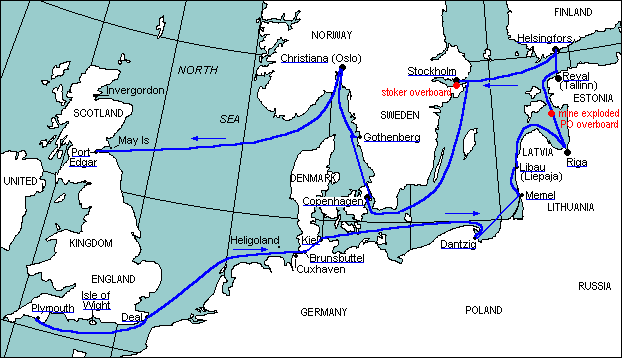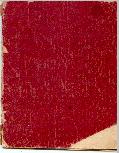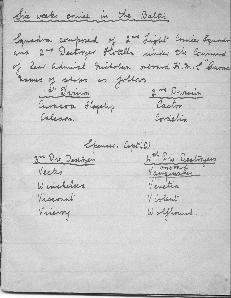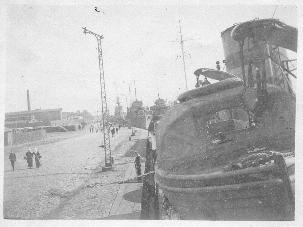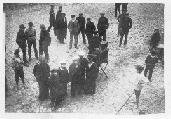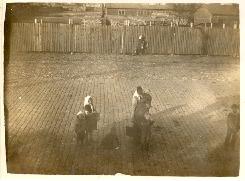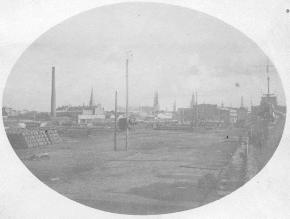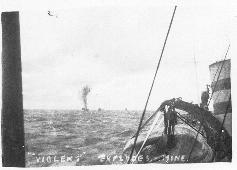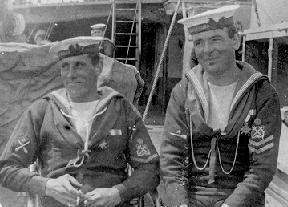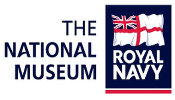Reval
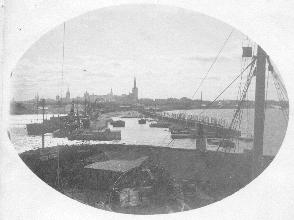
Reval
(above) from the outer arm of the jetty
showing the narrow entrance the ships had to come
through.
Saturday
(17 Sept) At 8 PM a mine was sighted at the
entrance to Reval, and the Violent was ordered to
sink it (see above).
While
the Fleet was stopped during this operation Petty
Officer Mitchell
(listed as Officer's
Cook 1c Frederick C MITCHELL L 4508 on the 17th)
of the Flagship
Curacoa was caught in one the Paravane wires &
dragged over the side and cut in two, his body
passed between the lines partly submerged, and
before it could be picked up, sank. Search was made
for the body for half an hour without results, so
Ensigns were half-masted & the Funeral Service
read over the spot where he sank. The Fleet then
proceeded underway for Reval.
On
arriving off the entrance the Fleet was met by a
squadron of Seaplanes which manoeuvred very well
considering the very high wind & rough state of
the sea.
The
Fleet formed into 3 columns in line abreast 3rd
Division of Destroyers leading followed by the 4
Light Cruiser at 2 1/2 cables apart, the fourth
Division of Destroyers bringing up the rear.
As
we rounded the point to the harbour, Reval presented
a very pleasing appearance with its large domed
churches showing up against a clear sky & back
ground. We were given to understand that we were to
go alongside the jetty, so steam was kept raised
ready to go alongside.
10
o'clock on Sunday morning (18 Sept). The
destroyers were ordered to proceed alongside the
outer arm of the Jetty, Vanquisher leading the way.
It was rather a ticklish piece of work as the ships
had to be manoeuvred through a small gap which
didn't allow for much room for turning as the
channel was very narrow with mud banks on either
side, and owing to the strong wind it was anything
but an easy job. We made two attempts before we
successfully negotiated the turn, but eventually we
secured alongside a small steamer, the other boats
coming in as the other ahead cleared the entrance.
The
President of Foreign Ministers invited all Captains
to lunch with him, while a concert was arranged at
the Town Hall for the men. An hours entertainment
was arranged, but as assistance in the way of turns
from the Fleet was asked for, it finished with a 3
1/2 hours entertainment.
I
didn't go ashore here, but from the reports the
outside appearance was far superior to the interior,
the streets were very narrow & dirty, the homes
badly needing repair etc.
Monday
(19 Sept) at 6 AM we left for Helsingfors the
capital of Finland, about 64 miles across the Gulf.
Helsingfors Capital of
Finland
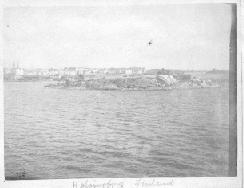
Entrance to
Helsingfors,
Finland
Helsingfors
was reached about 11 AM today Monday after a rough
passage across the Gulf from Reval
Sept
20th . The entrance to Helsingfors is
surrounded by numerous small islands, so it was
necessary to have Finnish pilots. Our pilot couldn't
speak English or French, but as he could speak
Russian, one of our Petty Officers who had been in
Russia for 2 or 3 years & could speak a little
Russian and so did the interpreting part of the
business & so got over the difficulty.
All
the Destroyers proceeded to the inner harbour &
the Light Cruiser to the other side of the Island.
The
people here were very civil & obliging. It is
one of the prettiest little seaports I've been to.
The streets were well laid out. The main street
especially was very pretty with extensive gardens
running through the centre.
Owing
to the rate of exchange which was 230 marks to the
£1 we found things very cheap. I purchased a lot of
glass ware, scent & several other things at a
very cheap rate.
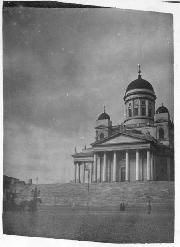 The
Franco Restaurant that I went into gave a very good
spread for 12 marks equivalent to 1/-. The orchestra
played while you had lunch. The lunch consisted of
steak, onions, potatoes & cabbage, with cheese,
Black & White bread & pats of butter all for
a bob.
The
Franco Restaurant that I went into gave a very good
spread for 12 marks equivalent to 1/-. The orchestra
played while you had lunch. The lunch consisted of
steak, onions, potatoes & cabbage, with cheese,
Black & White bread & pats of butter all for
a bob.
I
had a thorough good walk round here & it seemed
hard to realise Helsingfors is ice bound for 4
months of the year.
Our
stay at Helsingfors lasted for three days. I think
we all enjoyed ourselves here and would have liked
to stay for at least another week, but we had to
adhere to our original programme so the Fleet left
at 2 PM on Thursday (22 Sept) for out next
port of call, Stockholm the Capital of Sweden.
Cathedral at
Helsingfors (left)
with gilt domes. The General Post
Office & Archeological Society's building is
just behind the Cathedral
Stockholm, Sweden
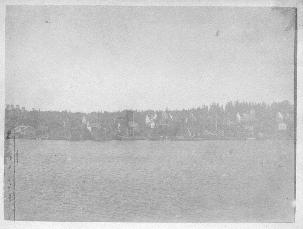
View
of the Pilot Station
where pilots were changed
After
leaving Helsingfors we caught rough weather crossing
the Baltic & all night long we were ploughing
through heavy head seas, tossing & rolling about
like corks, but as it was only a nights trip across
we didn't mind much. At 5 AM we were well under the
shelter of the Aland Islands & picked up Pilots
off the Island of Upsala to begin our 60 mile trip
up the Fjords to Stockholm.
The
scenery was magnificent all the way up, although
towards the close of the summer season the riverside
bungalows were gaily decorated. We passed a Swedish
Naval Base & Garrison about 20 miles before we
got to Stockholm, the Swedish Sailors standing to
attention as we passed quite close to the shore at
this point. Am afraid the snaps I took don't give a
very adequate view as to what it really looked like.
We
arrived off Stockholm at noon & proceeded direct
to the jetty to land Lt Donnell from our ship to
Hospital seriously ill.
The
remainder of the Fleet went & anchored close to
the oiler Petroleum that had been sent out from
England to fill us up with oil fuel as we had by
this time run fairly short of oil.
After
oiling all ships proceeded independently and
anchored in pairs off Stockholm.
The
Football team were to play the Swedish Navy at the
Stadium. The City is built something like Venice
i.e. on a group of Islands. I believe it is called
the Venice of the Baltic.
The
Royal Palace was quite close to our anchorage but
the King & Queen were away at the time. Concerts
& Balls were arranged for the Officers as usual,
the men having to shift for themselves. We played
the Swedish Navy at the Stadium & lost 3-4.
Things
were very dear here. The rate of exchange 16.80
against the pre war 18.44 made things much worse. It
cost you 1 Krona to open your mouth & 2 Krona to
shut it, not reckoning the cost to fill it.
Three
of us went into a Café & ordered steak,
vegetables & stout. The piece of steak was about
half the size of the palm or the hand with 2
potatoes & a spoonful of onions with a glass of
stout, price 21/- the three. Next move, exit the
three of us.
Everyone
here seemed to be the owner of a bicycle.
What
I saw of the place I thought very nice, but owing to
the lack of funds as the banks were closed & if
you wanted to change any money at the Café's they
diddled you over so that the £1 dropped in value
from 17/- at the banks to 13/- in the Café's, so we
weren't having any.
Life
in this place begins when it was time for us to
return onboard about 11.30 PM, so I didn't bother to
go ashore here again. This night a Stoker from the
flagship Curacoa fell overboard when coming off at
night & was drowned before he could be picked up
(believed to
be Stoker 1c Arthur BILLINGHURST K 57348 on
Saturday, 24 September 1921).
He was buried the next day with full honours.
Swedish Army & Navy lined the routes.
The
ships were open to visitors on Sunday (25 Sept).
We had crowds onboard, but very few of the men
offered to take the visitors round owing most
probably to lack of knowledge of the language,
although several who came could speak a little
English. Still it made it rather a stiff job trying
to make them understand things & also
understanding the large number of questions that
were being asked.
I
wasn't sorry to leave Stockholm. Why? I couldn't
say, except that I was disappointed with the place.
We
left at 9 AM on Tuesday Sept 27th for
Copenhagen about 500 miles distant. As we also had a
night attack to do we didn't anticipate reaching
Copenhagen until early on Thursday morning.
The
weather was still rather rough when we left.
Copenhagen, Denmark
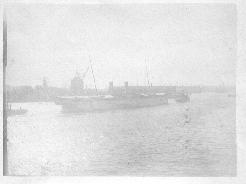
Royal
Danish Yacht proceeding up harbour after
the King had disembarked
We
arrived here at 8 AM today Thursday Sept 29th.
The
Destroyers proceeded up harbour with the Flagship.
The other three Light Cruisers remaining outside.
Friday
30th H.M King of Denmark arrived in his
Yacht accompanied by three Destroyers.
As
soon as H.M. the King arrived, ships were dressed
& manned as the Yacht made way to her moorings
just abreast us.
The
King didn't remain long after arrival, but proceeded
ashore in his steamboat for the palace. He was due
back at 2PM to inspect the Flagship & did so as
Hon British Admiral for which he received a 17 gun
salute, the forts returning same.
All
Captains were commanded to dine with him at 7 PM on
Saturday Oct 1st.
Invitations
were received for Officers to pay a visit to the
Porcelain Factory.
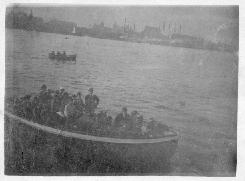
Visitors
coming alongside at Copenhagen
The
Danes are a very likeable, kind people, our men made
many friends here, consequently visitors came
onboard in large numbers.
The
town itself is planned on quite a large scale as
regards the width of the roads, in the form of
avenues with a special track for bicycles. As
bicycles are very cheap here everyone seems to own a
machine. The Langalene Gardens that run parallel to
the river possess some very fine monuments of which
I took snaps of several, although it was raining
slightly when I went onshore. We had a very pleasant
stay her of 4 days & were sorry to leave.
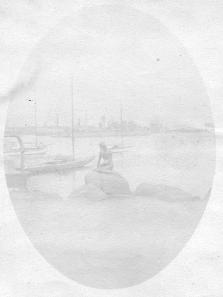
Bronze
Mermaid on the Langalene Front, the
Destroyers
Vanquisher, Violent & Venetia are in the middle
distance
